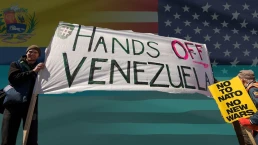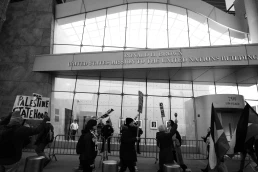As the US is scrambling to maintain its hegemony, anti-war voices critical of US militarization policy in the war in Ukraine or around China are red-baited and silenced
By Matthew Philips, Peoples Dispatch
On August 5, a New York Times article accused anti-war organizations and individuals [in particular Roy Neville Singham] as being part of a global Chinese funded network that “push[es] Chinese talking points worldwide.” In response, on August 9, Republican Senator Marco Rubio requested a US Department of Justice investigation into whether “Singham, and left wing pro-CCP organization, are complying with FARA [Foreign Agents Registration Act].”

Across the globe in India, amidst growing anti-China sentiment, the right-wing Narendra Modi government’s Minister of Information and Broadcasting accused “NewsClick [an outlet known for its critical coverage of Modi’s policies] of spreading an ‘anti-India agenda, citing the New York Times [article].” Then, two months later, on October 3, the Modi government dealt a blow to India’s freedom of the press when Indian police arrested and raided the offices of NewsClick’s journalists.
As the world order is being upturned, the US is scrambling to maintain its hegemony, pushing a narrative about an aggressive China and Russia, and anti-war voices critical of US militarization policy in the war in Ukraine or around China are red-baited and silenced.
Despite being ill-positioned to wage a direct war with Russia, let alone Russia and China, the White House is explicit about the need for military buildup around Ukraine and in the Indo-Pacific region around China. Even as the world faces multiple crises, the US leads the war towards greater conflict while insisting that it is promoting peace and democracy.
To work towards just solutions to the world’s problems requires challenging and dismantling the New Red Scare that is silencing the voices for peace and justice and pushing a New Cold War. To do this successfully requires us to understand the mechanisms that continue to enable and enforce a Red Scare.
US pivots to war
The US’ China containment policy, ratcheting up tensions in the region, can be traced back to Obama’s Pivot to Asia. Obama’s 2010 Pivot to Asia, which expanded US naval presence in Northeast Asia, was premised on a view of China as belligerent. Since then, rather than intimidating China, US militarization has “encouraged Chinese leaders to believe that only adopting belligerent policies will [allow China to] guarantee its security.”
In effect, the US is fueling a dynamic that is ratcheting up tensions and leading us towards war. Despite lacking the bullets, and the capacity to produce them, to wage war with Russia and China, there is little discussion about the need for de-escalation, peace, and collective actions around the multiple crises facing the world.
Instead, the focus is on a dramatic and rapid build-up of the US military industrial capacity, Herculean in its challenge and destructive for climate change. Buttressing this drive towards war is a new McCarthyism silencing the voices for peace. Understanding its formation and dynamic is key in opening up discussion for peace.
The Red Scare
The first Red Scare, during World War I, targeted anti-war voices such as conscientious objectors. Socialists were expelled from the New York assembly, radical groups were infiltrated by the government, and many were arrested and deported. In the 1920 Palmer Raids, 6,000 people were arrested and a tenth of them deported.
This period laid the legal infrastructure—1939 Hatch Act, 1940 Smith Act, and 1947 Executive Order 9835 (EO9835)—enabling the McCarthyism of the late 1940s and mid 1950s.
The Hatch Act blocked federal employees from joining a political organization, the Smith Act made it illegal to advocate for the overthrow of the government by force, and EO9835 instituted Loyalty Oaths as a social and legal norm. Combined, all three created the infrastructure to wage a lawfare campaign that spread paranoia, normalizing and justifying a norm of guilt by association that violated due process and divided society.
McCarthyism would “peter out in the late 1950s” as Senator Joseph McCarthy’s reckless and headline-seeking roster of high-level targets generated resistance and backlash even from his own party. Nonetheless, it “gutted the American left and narrowed the entire political spectrum.” Tactics from the era are being used once again to push an agenda that positions China as an enemy within the context of the New Cold War.
One parallel we see playing out today is the PRISM program, with its far greater potential to surveil and fuel witch-hunts against political opponents, much like J Edgar Hoover’s surveillance fueled McCarthyism.
The PRISM program has become a tool for the US government to engage in political and economic espionage. As recently as 2022, “the majority of [PRISM’s targets] appear to be a matter of political surveillance rather than defense against terrorism.”
A mere four years after President Obama successfully ridiculed his opponent Mitt Romney’s Russia concerns as a “throwback” to the 1980s, the Democrats embraced Romney’s “throwback” demonizing of Russia.
Pulitzer Prize winning journalist Glenn Greenwald details how “Russia continues to be the all-purpose villain” to be used by Western elites. Russia is blamed for Hillary Clinton’s failed 2016 presidential bid, for the victory of leftist Robert Fico’s in Slovakia, for Niger’s ejection of the French military, for growing public skepticism in the US, for declining support for Ukraine, and the Canadian parliament’s gaffe honoring a Nazi SS soldier.
When high-ranking politicians, like Rubio, succeed in criminalizing freedom of conscience, the space for disagreement and dissent shrinks. The investigation against the Uhuru Movement for allegedly “sow[ing] discord and corrupt[ing] US elections in service of hostile foreign interests” or groups such as The People’s Forum, targeted in the New York Times article focused on Neville Roy Singham’s financial contributions to leftist organizations.
Limiting the discourse on matters of war and peace has real consequences. In April 2023, leaked Pentagon high level reports revealed a pessimistic assessment of a Ukrainian offensive. Nonetheless, the media discourse has been dominated by stories about Ukraine’s impending historic breakthrough, presumably to secure the smooth passage of new funds from Congress. Would such funds be so freely disbursed if there were a more honest conversation and debate established?
Censoring peace
By the time Trump became president, the Democrats had embraced a full-throated McCarthyite stance pressuring Trump towards a more anti-Russia position. Trump inflamed the situation by sending weapons to Ukraine. As Biden was finishing his first year, Russia proposed a new security architecture for Europe that reflected its security concerns. Russia’s core demand for an assurance that NATO expansion towards its borders would stop was rejected.
When war started in Ukraine, the public record of high level US and NATO officials, including Biden, acknowledging how NATO expansion could provoke a Russian attack were covered up. What had been “uncontroversial and widely acknowledged” became taboo once the war started. And those that proposed diplomatic solutions were smeared as Putin apologists.
A Manichaean view, epitomized in Bush’s “either you are with us… or you are with the enemy” and currently manifested in the new Red Scare, creates a thought-terminating worldview where a negotiated peace settlement in Ukraine is irrational, unpatriotic, and mentioning anything positive about China labels you a mere sympathizer.
Thus, while Chinese human rights violations dominate discussion, little is mentioned about the 800 million Chinese people taken out of extreme poverty in the past decades. And little in the way of actual evidence is offered in the former case.
Furthermore, the media coverage of war eclipses the actions we need to take to address climate change. Little is mentioned about the imprisonment of Julian Assange, whose Wikileaks exposed the heinous nature of US military occupation.
We should be talking about how the US and NATO provoked the war in Ukraine by treating it as a NATO member through its annual “classes, drills and exercises involving at least 10,000 troops annually for more than eight years” rather than obsessing about pop psychology profiles of Vladimir Putin. We should be talking about peace, not war. But none of this fits within the mainstream narrative media’s Marvel comic portrayal that labels the West as a democratic garden, and everywhere else as evil, autocratic jungle.
Those that call China an enemy of the US have yet to tell us how and why that is so. The Western media repeatedly fails to uphold the basic tenets of good journalism when painting China as a global threat. China’s last armed conflict was the four-week Sino-Vietnamese War in 1979.
In contrast, since 1945, when it “cast itself as the global peacekeeper,” the US has been in a state of endless war and invasion, not to mention its 20-year wars in Afghanistan and Iraq. And yet based on media portrayals, Russian or Chinese spy balloons are flying all around us. Why does the US conjure imaginary enemies? For armaments to be manufactured and generate profit for the war industry, public consent also needs to be manufactured. Without such an enemy, real or perceived, maintaining military budgets ten and a hundred times the size of most countries would be impossible.
Recent Posts
Are Zohran Mamdani and Katie Wilson Democratic Socialists or FDR Democrats? They Are Both
November 23, 2025
Take Action Now This is fitting: For more than a century, socialism has been integral to American progressivism, championing early many of the…
Leaders Across EU Deliver Unified Message to the US: ‘No War on Venezuela’
November 22, 2025
Take Action Now “We condemn in the strongest terms the military escalation against Venezuela,” said progressive leaders from countries including the…
Who Is Ready To Die For Trump’s Gaza Plan? So Far, Nobody
November 21, 2025
Take Action Now Trump has claimed that all sides agreed to his peace plan, but Hamas only agreed to the first stage of it, which involved returning…
Less For Health Care, More For The Pentagon
November 21, 2025
Take Action Now Even with U.S. health premiums set to double, senators gave essential health funds as a bonus to the $1 trillion Pentagon.By…




